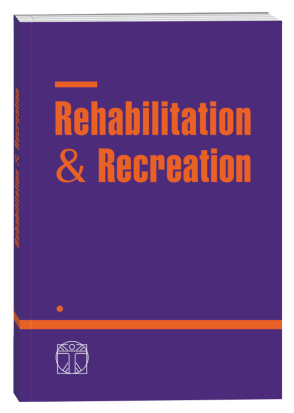PHYSICAL ACTIVITY AMONG ADULT POLES SUFFERING FROM TYPE 2 DIABETES
DOI:
https://doi.org/10.32782/2522-1795.2023.15.19Keywords:
physical activity, physical fitness, diabetes type 2, pre-diabetes.Abstract
There is a lot of evidence confirming that a healthy diet and physical activity have a significant impact on the prevention of type 2 diabetes. The benefits of lifestyle changes are enjoyed by both people with revealed type 2 diabetes and those with prediabetes, which precedes the development of diabetes. Type 2 diabetes is most often suffered by people with excessive body weight, in particular patients with excessive adipose tissue located in the visceral region. Obtaining a weight loss of 5% within 4 years reduces the incidence of diabetes in obese people by 58%. Lifestyle modification through the introduction of regular physical activity and a healthy diet effectively improves the regulation of sugar levels, both fasting glycaemia and the level of glycated hemoglobin HbA1c. Physical activity, lifestyle and health are inextricably linked. The human body, both for development and for optimal functioning, without diseases, needs movement, which significantly affects the length and quality of human life. All centers involved in the treatment of diabetes, including the Polish Diabetes Society, recommend regular physical activity to people with glycemic disorders. The diabetes epidemic is spreading fast. It is estimated that in 2025, around 300 million people will suffer from the disease in the world. Such a dynamic increase in the incidence is mainly due to the situation in developing countries, where the number of patients will increase by 170%. Therefore, more emphasis should be placed on the prevention of type 2 diabetes. The basic method of preventing this disease is a proper diet and appropriate physical activity. The results indicate that despite the fact that Poles suffering from type 2 diabetes know that physical activity has a significant impact on extending life (90% of respondents), only half of the respondents engage in regular physical activity.
References
Andrieieva O., Maltsev D., Kashuba V., Dutchak M., Ratnikov D., Grygus I., Byshevets N., Horodinska I. (2022). Relationship Between Quality of Life and Level of Physical Activity and Family Well-Being. Physical Education Theory and Methodology, 22(4), 569-575. https://doi.org/10.17309/tmfv.2022.4.16
Cichocka A. (2022). Stan przedcukrzycowy i cukrzyca typu 2. Dieta i styl Życia. Medyk. 17-19.
Czarnecki D., Skalski D. W., Kowalski D., Vynogradskyi B., Grygus I. (2022). Aktywność fizyczna seniorów warunkiem zdrowia i dobrej jakości życia. Rehabilitation & recreation. 12. 105-112. https://doi.org/10.32782/2522-1795.20 22.12.15
Diachenko-Bohun M., Hrytsai N., Grynova M., Grygus I., Skaliy A., Hagner-Derengowska M., Napierała M., Muszkieta R., Zukow W. (2020). Historical Retrospective of the Development of Scientific Approaches to Health-Saving Activity in Society. International Journal of Applied Exercise Physiology, 9(1), 31-38.
Grygus I., Mykhaylova N. (2013). Wpływ ruchowej aktywności na stan zdrowia studentów. Journal of Health Sciences. 3 (5): 649-656.
Grygus I., Nesterchuk N., Skalski D., Zabolotna O. (2021). Edukacja w polskim społeczeństwie nowoczesnym a edukacja zdrowotna. Kultura fizyczna, edukacja zdrowotna i bezpieczeństwo. Gdańsk, 81-97.
Grygus I., Jewtuch М. (2013). Wpływ zaproponowanej metodyki wychowania fizycznego na stan funkcjonalny studentów. Journal of Health Sciences. 3(9), 417-426.
Kashuba V., Andrieieva O., Yarmak O., Grygus O., Napierala M., Smolenska O., Ostrowska M., Hagner-Derengowska M., Muszkieta R., Zukow W. (2021). Morpho-functional screening of primary school students during the course of physical education. Journal of Physical Education and Sport. 21(2):748-756.
Moshynsky V., Мykhaylovа N., Grygus I. (2013). Podwyższony poziom zdrowia przez stosowanie się do zdrowego stylu życia. Journal of Health Sciences. 3 (10): 123-132.
Nesterchuk N., Grygus I., Ievtukh M., Kudriavtsev A., Sokolowski D. (2020). Impact of the wellness programme on the students’ quality of life. Journal of Physical Education and Sport, Vol 20 (Supplement issue 2), 929–938.
Nesterchuk N., Grygus I., Tokar A., Skalski D.W. (2022). Nowoczesne technologie fitness. Ochrona zdrowia. Wybrane aspekty edukacyjno-medyczne. Monografia. Red. D.W. Skalski, I. Grygus. 113-128. https://doi. org/10.5281/zenodo.5904194
Nesterchuk N.O., Kulaj O., Grygus I., Skalski D. (2021). Fitness and physical therapy of obesity patients. Zarzadzanie kultura fizyczna zdrowiem i bezpieczeństwem. Starogard Gdański, 56-64.
Ostrowska L., Orywal K., Stefańska E. (2018). Diagnostyka Laboratoryjna w Dietetyce, PZWL. 106 s.
Skalski D., Kowalski D., Grygus I., Nesterchuk N. (2020). Physical culture in a rural environment and health education. Rehabilitation & recreation. 6. 76-88. http://doi.org/10.5281/ zenodo.4033295
Skalski D., Kowalski D., Grygus I., Zabolotna O. (2021). Rola rodziny i państwa w wyrównywaniu szans życiowych dzieci pochodzących z różnych środowisk społecznych a edukacja zdrowotna. Zarzadzanie kultura fizyczna zdrowiem i bezpieczeństwem. Starogard Gdański.
Skalski D.W., Grygus I., Skalska E., Rybak L. (2022). Współczesna kultura fizyczna a styl życia. Spektrum peregrynacji po kulturze fizycznej dla mistrzów wychowania fizycznego: Scientific monograph. Praca zbiorowa pod redakcją Białasa M. i Skalskiego D.W. Gdańsk. 21-34.
Włodarek D., Lange E., Kozłowska L. i wsp. (2015). Dietoterapia. Wydawnictwo Lekarskie PZWL, Warszawa. 88 s.
World Health Organization: Physical activity strategy for the WHO European Region 2016-2025. World Health Organization, 2016. 167 s.
Zalecenia kliniczne dotyczące postępowania u chorych na cukrzycę. 2022. Stanowisko Polskiego Towarzystwa Diabetologicznego https://ptdiab.pl/images/ docs/zalecenia/CTiD-1-2022-pl.pdf
Downloads
Published
How to Cite
Issue
Section
License

This work is licensed under a Creative Commons Attribution-NonCommercial-NoDerivatives 4.0 International License.











